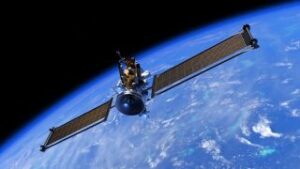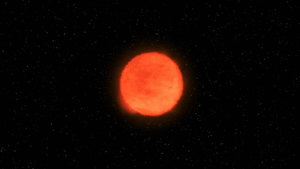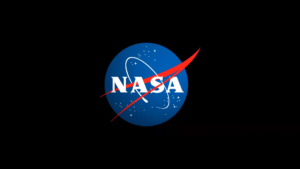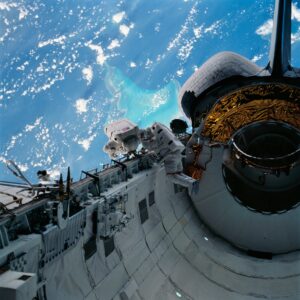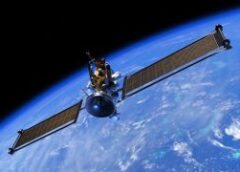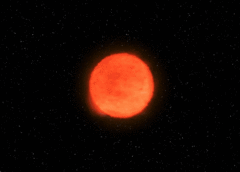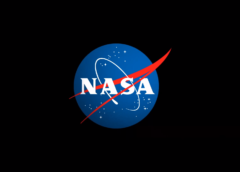NASA A model of the Mariner-C spacecraft seems to float in the darkness of space in this photo from a June 1964 Conference on New Technology at NASA’s Glenn Research Center in Cleveland. Mariner-C and Mariner-D were identical spacecraft designed by NASA’s Jet Propulsion Laboratory to fly by Mars and photograph the Martian surface. Mariner-C was launched on Nov. 4, 1964, but the mission ended unsuccessfully two days later. Mariner-D, or Mariner 4, launched on Nov. 28, 1964, and became the first successful mission to Mars, as well as the…
Read MoreAero Engineer Brings NASA into Hawaii’s Classrooms
On the left, NASA Ames engineer Evan Kawamura on his first day of sixth grade with teacher Kristen Stoker of Hanalani Schools. On the right, Kawamura reunited with Mrs. Stoker when speaking to her students about his work at NASA. The field of aerial vehicle autonomy focuses on self-reliance, building the flight equivalent of puppets without puppeteers. Behind the scenes, however, is a rich network of people and systems that work together to develop frameworks, test new technologies, and inspire a pipeline of engineers to create the breakthroughs of the…
Read MoreNASA Orbiter Snaps Stunning Views of Mars Horizon
4 min read NASA Orbiter Snaps Stunning Views of Mars Horizon This unusual view of the horizon of Mars was captured by NASA’s Odyssey orbiter using its THEMIS camera, in an operation that took engineers three months to plan. It’s taken from about 250 miles above the Martian surface – about the same altitude at which the International Space Station orbits Earth. NASA/JPL-Caltech/ASU The Odyssey orbiter captured clouds and dust in the Red Planet’s skies, along with one of its two tiny moons. Astronauts often react with awe when they…
Read MoreThe Mars helicopter Ingenuity is an amazing success. NASA’s already testing tech for the next generation (video)
NASA recently released a video showing a pair of Mars helicopter rotor blades getting tested at the agency’s Jet Propulsion Laboratory (JPL). The test occurred on Sept. 15, just one day before NASA’s Ingenuity helicopter made a record-breaking flight on the Red Planet. With Ingenuity’s major success, NASA is planning to incorporate helicopter-like drones into future Mars missions too, built with designs more robust than their predecessor — which has completed 66 flights, and counting. The new dual rotor system recently tested at JPL features two carbon-fiber blades measuring more…
Read MoreNASA Leadership to Participate in Global Climate Change Conference
NASA Administrator Bill Nelson delivers remarks before the ribbon cutting ceremony to open NASA’s Earth Information Center, Wednesday, June 21, 2023, at the Mary W. Jackson NASA Headquarters building in Washington. The Earth Information Center is new immersive experience that combines live data sets with cutting-edge data visualization and storytelling to allow visitors to see how our planet is changing. NASA/Joel Kowsky NASA Administrator Bill Nelson and other agency leaders will participate in the 28th United Nations Climate Change Conference of the Parties (COP28) beginning Thursday, Nov. 30, through Tuesday,…
Read MoreMysterious blasts of radiation might stem from our universe’s most extreme stars
New research has revealed that different types of neutron stars, born when massive stars die, behave in a similar way. This might sound like a minor result, but in the grand scheme of things, it’s a finding that further supports the idea that these extreme dead stars — so dense a tablespoon of one equals something like the weight of Mount Everest — could be behind mysterious blasts of radiation called Fast Radio Bursts (FRBs). Millisecond-long bursts of radio emission FRBs seem to come from sources beyond the limits of…
Read MoreNASA to Showcase Earth Science Data at COP28
3 min read NASA to Showcase Earth Science Data at COP28 This illustration shows the international Surface Water and Ocean Topography (SWOT) satellite in orbit over Earth. SWOT’s main instrument, KaRIn, helps survey the water on more than 90% of Earth’s surface. Credit: NASA/JPL-Caltech. NASA/JPL-Caltech With 26 Earth-observing satellite missions, as well as instruments flying on planes and the space station, NASA has a global vantage point for studying our planet’s oceans, land, ice, and atmosphere and deciphering how changes in one drive change in others. The agency will share…
Read MoreScientists suspect there’s ice hiding on the Moon, and a host of missions from the US and beyond are searching for it
Building a space station on the Moon might seem like something out of a science fiction movie, but each new lunar mission is bringing that idea closer to reality. Scientists are homing in on potential lunar ice reservoirs in permanently shadowed regions, or PSRs. These are key to setting up any sort of sustainable lunar infrastructure. In late August 2023, India’s Chandrayaan-3 lander touched down on the lunar surface in the south polar region, which scientists suspect may harbor ice. This landing marked a significant milestone not only for India but for the…
Read MoreFestive Northern Lights
The spectacular aurora borealis, or the “northern lights,” over Canada is sighted from the space station near the highest point of its orbital path. The station’s main solar arrays are seen in the left foreground. NASA The aurora borealis adds a bit of flair to our home planet in this image taken from the International Space Station on Sept. 15, 2017. This phenomenon happens because the Sun bathes Earth in a steady stream of energetic particles, magnetic fields and radiation that can stimulate our atmosphere and light up the night…
Read MoreNASA Releases Its First International Space Station Tour in Spanish
Lee esta nota de prensa en español aquí. Record-breaking NASA astronaut Frank Rubio provides the agency’s first Spanish-language video tour of humanity’s home in space – the International Space Station. Rubio welcomes the public aboard the microgravity science laboratory in a behind-the-scenes look at living and working in space recorded during his 371-day mission aboard the space station, the longest single spaceflight in history by an American. The station tour is available to watch on the agency’s NASA+ streaming platform, NASA app, NASA Television, YouTube, and the agency’s website. Continuously…
Read More